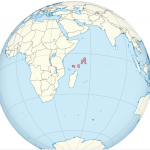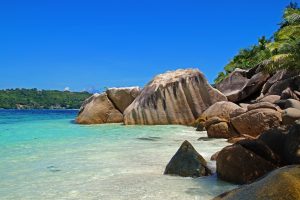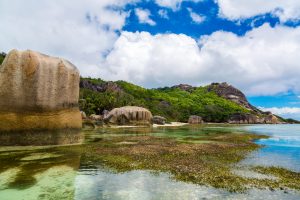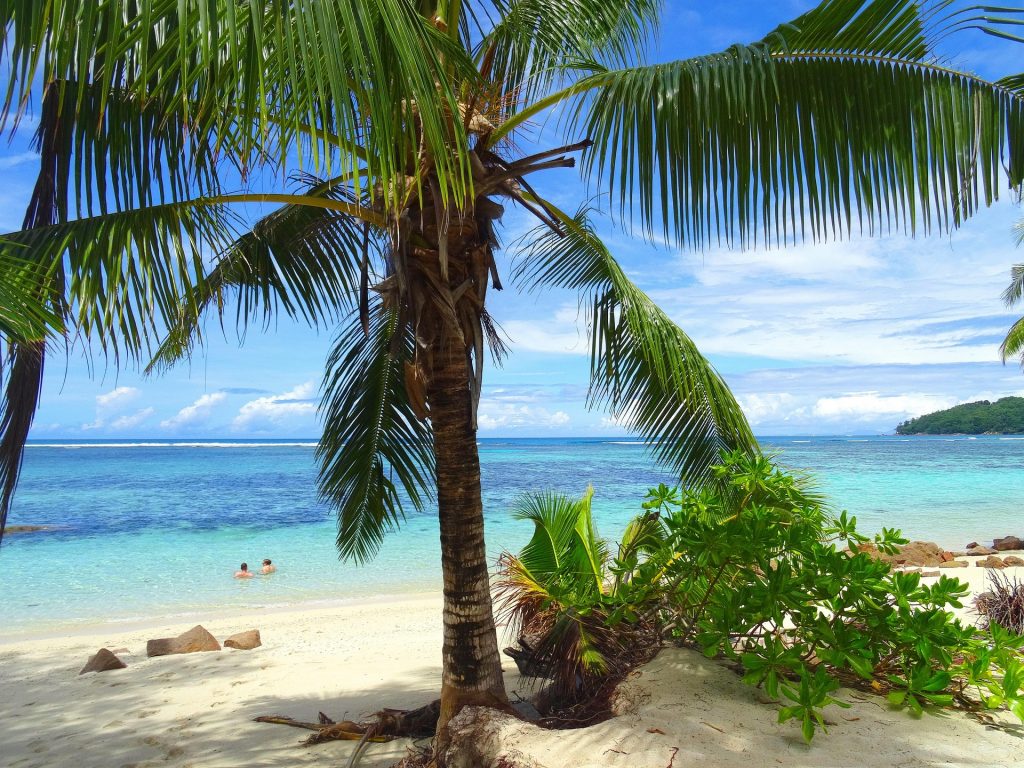Lifting the Veil
Seychelles presents a picturesque archipelago in the middle of the Indian Ocean, a tropical paradise renowned for its crystal clear waters, flawless white sandy beaches, and lush palm fringed trees gently swaying in a warm breeze. The vibrant marine life and stunning coastlines attract tourists from around the world and contribute 46.2% of its $1.67 billion GDP.1 The pristine sandy beaches of the Seychelles veil dark secrets: amidst a sly complex security situation, an insidious human trafficking industry preys on the lives of the innocents, turning the tranquil tropical nights in paradise into a nightmare. Beneath this idyllic facade lie challenges that threaten Seychelles’ security, economic stability, and societal well-being: from piracy, political corruption, drug and human trafficking, economic dependency, to environmental vulnerabilities. These issues pierce through the paradisiac perception from this tiny island nation, a modern-day Eden ridden by serpents lurking in the sand waiting to strike. What opportunities may present themselves to provide more security to assure survival in the midst of this despair where pirates, traffickers, and corrupt public officials thrive? Let’s examine the maritime threats, economic and environmental pressures, and the sovereignty concerns to propose a path forward.

Maritime Security and Illegal Activities
Stretching like a sapphire cloak across the Indian Ocean, Seychelles’ vast Exclusive Economic Zone (EEZ) leaves it vulnerable to a tempest of transnational threats— from human trafficking, corruption, piracy, illegal fishing, to drug trafficking— these gnaw at its economic foundations, erode its sovereignty, and scar its fragile ecosystems. Beneath the postcard beauty of its beaches lies a harsher reality: poverty, depleted resources, and the long shadows of colonial rule that feed the flames of trafficking and violence. Amid this turmoil, a growing tide of addiction surges on the inland, where heroin destabilizes communities— opioids has its grip near 10% of the population, turning this paradise into a battleground for public health and human dignity.2 The nation’s strategic location makes it a transit hub for cartels smuggling narcotics to East and Southern Africa, Madagascar, and beyond.3 Piracy presents a perilous provocation to national sovereignty with armed assailants prowling the Exclusive Economic Zone (EEZ) and preying on passing vessels. In parallel, illegal fishing fleets plunder precious marine resources endangering both economic prosperity and ecological preservation. These maritime menaces further magnified by human trafficking networks cruelly coerce and commodify the most vulnerable—particularly children and migrant women—for sexual servitude within Seychelles, while also subjecting Seychellois citizens to forced labor in far-flung foreign lands.4
Corruption fuels the engine of Seychelles’ ongoing struggles, corroding institutions from within. The dramatic dissolution of the National Drugs Enforcement Agency (NDEA) under the cloud of corruption allegations forced a handover of power to the police and the Anti-Narcotics Bureau (ANB), shifting the burden onto already strained shoulders.5 Yet pervasive graft continues to cripple enforcement efforts like creeping vines strangling the foundations of justice.6 When left unchecked, this systemic rot empowers criminal networks to burrow deeper, gnawing away at the Seychelles national stability. Only a multifaceted strategy can respond to the multiple stressors. Education campaigns can teach children to recognize traffickers’ tactics—grooming, secrecy, manipulation—while public awareness and vigilant reporting stand as sentinels of prevention and stewards of security.7 However, education alone cannot provide economic growth necessary to sustain growth opportunity for locals while not depleting its resources. Therefore, could international investment increase security?
Could a U.S. Naval base bring a panacea?
A U.S. naval base could serve as a sentinel of the sea, casting an unblinking eye across the vast blue expanse of Seychelles’ Exclusive Economic Zone. With the sweep of high-tech surveillance, the silent glide of drones, and the swift hand of interdiction, it could sever the shadowy arteries of drug routes, scatter pirate fleets like smoke in the wind, and drive out illegal fishing vessels that plunder the ocean’s bounty. Coupled with fortified regional alliances and deep-rooted anti-corruption reforms, such a presence could shield coastal communities, breathe life back into overfished waters, and restore Seychelles’ rightful command over its maritime domain. Could such a sweeping and sustained strategy unshackle the Seychelles from the grip of lawlessness and chart a course toward lasting regional security and sovereignty?
Climate Change and Environmental Vulnerability
Seychelles, with a GDP of $1.67 billion in 2023 and 25% of its 99,258 population in poverty, relies heavily on tourism and fishing, which face mounting threats. 8 Tourism drives nearly 46.2% of Seychelles GDP, yet climate change looms like a slow-moving storm with rising seas and climbing temperatures that threaten to wash away 10-20% of that revenue the 2050s.9 Illegal, unreported, and unregulated (IUU) fishing erodes fisheries, a sector comprises 45% of the total economic output, with losses estimated at $10-20 million annually due to overexploitation.10 The Blue Economy Plan counters these risks with sustainable fisheries, Marine Protected Areas covering 30% of its EEZ, renewable energy, eco-tourism, maritime security, and Blue Bonds, aiming to diversify revenue stream.11
China’s distant waters fishing fleet (DWF) deployed across every ocean, exacerbates Seychelles’ fishery losses, with over 60% of its vessels engaged in IUU fishing. The fleet is “often found guilty of violating the domestic laws of the respective countries and the United Nations Convention on the Law of the Sea (UNCLOS). China also indulges in targeting endangered species, falsifying licenses & documentation, espionage & reconnaissance activities, seizing territories, generating a lot of sea waste, and violating EEZs of other nations,” serving Beijing’s foreign policy objectives.12& 13 “Counternarcotics task forces could bring additional expertise and resources to countering illegal unreported and unregulated (IUU) fishing, especially in areas where drug trafficking and illegal fishing overlap geographically or within the same organizations,” highlighting links to national security.14 The UK leverages its Commonwealth ties for stability, and France, via Réunion, maintains a naval presence, enhancing maritime security through “intense cooperation on shared priorities such as maritime safety and security, the blue economy, disaster risk management and the preservation of the marine environment”.15 Intensifying great-power rivalry presses Seychelles to defend its sovereignty while navigating foreign influence, even as climate change batters its coastlines and threatens to swallow vital infrastructure.
So what about adding a U.S. Naval Base?
The U.S. and Seychelles could anchor regional security, fortify the economy, and safeguard sovereignty by creating a naval base– modeled after Hawaii’s Joint Base Pearl Harbor-Hickam– to diversify Seychelles’ $1.67 billion economy. This option can potentially contribute $80-$160 million annually, drawing inspiration from Hawaii’s $8.7 billion military budget that fuels an economic engine of $75 billion.16 Hawaii’s bases support 102,000 jobs and secure Pacific trade routes, but 6% land militarization and pollution—such as the Red Hill fuel leak in 2021, which contaminated drinking water for thousands—raise significant concerns.17 For the Seychelles, such a base could protect its interest to recover $15 million annually from IUU fishing and to address drug trafficking, complementing France’s security role while countering China’s DWF.18 The exclusive military installation, Diego Garcia (UK/US) in the Chagos Archipelago, spurred a 15-20% economic uplift but also caused environmental damage and sovereignty loss.19 Seychelles’ government must weigh economic gains against a potential 5-10% local emission increase and France’s existing presence.20 “…[T]he opposition’s charge against…[a] base gained a great deal of public support. The project became so entrenched…[regarding] the debate over sovereignty that no government was likely to find it politically feasible.”21 Feasibility is low without mitigation—public resistance to foreign militarization and pollution fears suggest limited acceptance unless benefits could be guaranteed.

Addressing Sovereignty Concerns
A carefully structured bilateral security partnership can mitigate concerns about Seychelles hosting foreign military presence. The United States could sign a Defense Cooperation Agreements (DCAs) similar to the ones that enable joint operations while preserving host nation sovereignty, as demonstrated with Japan and the Philippines.22 Such agreements could prioritize maritime security collaboration ensuring Seychelles retains full control over its territorial waters, laws, and economic policies, including its Blue Economy initiatives.
This partnership would counter external geopolitical pressures, notably China’s growing influence in Africa, where its distant-water fishing fleet violates Seychelles’ Exclusive Economic Zone (EEZ) with over 60% IUU fishing.23 By aligning with the U.S., Seychelles can assert an independent foreign policy, reducing reliance on any single power while enhancing maritime security. A U.S. naval base could provide robust defense infrastructure recovering fishing revenues, and foster diplomatic ties with regional players like India and the African Union, which in turn would strengthen Seychelles’ regional standing.24
Achieving feasibility requires addressing public resistance and environmental risks. Strict ecological standards and joint oversight could mitigate pollution concerns and ensure the base aligns with Seychelles’ sustainability goals. Recommendations include negotiating a DCA with transparent sovereignty clauses and partnering internationally to fund green technologies, balancing security gains with national autonomy.25
Lifting the Veil: A Path Forward
Seychelles faces a pivotal choice amid rising piracy, trafficking, and economic dependency. With 25.3% of the population estimated to live below the national poverty line and 46.2% of its $1.67 billion GDP tied to tourism, the nation remains vulnerable to climate-driven revenue losses (10-20% by 2050) and IUU fishing, costing $10-20 million annually.26 Drug trafficking further destabilizes the nation.27 A U.S. naval base offers a strategic solution, enhancing maritime security, discouraging IUU fishing, and addressing trafficking through counternarcotics expertise.28 Modeled on Hawaii’s Joint Base Pearl Harbor-Hickam, it could contribute $80-160 million annually, diversifying the economy while reinforcing sovereignty through a Defense Cooperation Agreement.29
Yet, challenges remain. Public resistance to foreign militarization, the unavoidable 10% emission increase, and geopolitical tensions with China’s distant-water fleet require careful navigation.30 Seychelles should negotiate a DCA with strict ecological standards, conduct public consultations, and secure international funding for green technologies. Regional partners like India and the African Union can support satellite based IUU monitoring, ensuring a secure, sustainable future. By investing in maritime security, Seychelles can protect its natural resources, stabilize its economy, and safeguard its people from transnational threats. Lifting the dark veil over this tropical paradise begins with bold action to build a thriving, resilient Seychelles in the 21st century.
Updated Findings
Although placing a U.S. naval base in Seychelles may seem strategically ideal—given its location and proximity to key maritime routes— further research reveals significant complications for Seychelles. Admittedly, having a base on Seychelles would bolster regional security by deterring piracy, drug trafficking, and human trafficking, while supporting local maritime law enforcement and protecting Seychelles’ vast Exclusive Economic Zone (EEZ) from piracy. Notably, the country has already played a vital role in anti-piracy efforts, even hosting an EU-funded Regional Coordination Operations Centre for maritime security.31 In addition to this, both China and India desire a military presence there as well, but the people of Seychelles fear being caught in the crossfire and losing their sovereignty.

Yet, pursuing the most strategically sound solutions does not always lead to feasible outcomes. Seychelles faces chronic water scarcity, with the main island of Mahé currently meeting only 60% of its freshwater demand—a gap projected to widen as water needs rise by 130% by 2030.32 Its thriving tourism sector further intensifies this strain since visitors consume significantly more water and electricity than local residents.33 Desalination plants help supplement the water supply. Seychelles currently has four active desalination plants. They are costly, energy-intensive, and environmentally burdensome plus they produce brine that threatens the marine ecosystems. Seychelles’ government must weigh these economic gains against significant environmental risks, including saline intrusion into its water system, which has increased salinity in coastal wells by as much as 15% between 2000 and 2010, threatening freshwater availability.34 Introducing a naval base, with its substantial infrastructure and water requirements, will only exacerbate these challenges further. Drawing too much groundwater invites saltwater to creep into the aquifers, especially in La Digue, where it transformed once-safe drinking water into a briny, unusable resource. A U.S. naval base would intensify the pressure on these already strained reserves, by tapping into a system that is near its breaking point, though the promise of enhanced security remains tangible, the mounting environmental and economic costs continue casting a cloudy veil over Seychelles– one that must be lifted to break the shackles of survival and reveal a spirit of freedom and sustainable peace beneath the islands sunlit kissed skies.
- World Bank, Oct. 20, 2024, Seychelles Overview: Development news, research, data, https://www.worldbank.org/en/country/seychelles/overview/ retrieved 3/9/2025. ↵
- U.S. Department of State, January 6, 2025, 2024 Trafficking in Persons Report: Seychelles, https://www.state.gov/reports/2024-trafficking-in-persons-report/seychelles/, retrieved on 3/9/2025 and Mamelles, L., February 20, 2020, Addiction in Paradise: Seychelles Battles Heroin Crisis, France24, https://www.france24.com/en/20200220-addiction-in-paradise-seychelles-battles-heroin-crisis , retrieved 3/9/2025. ↵
- Moonien, et al., 2021, The Evolving illicit Drug trade in the Western Indian Ocean, Global Initiative Against Transnational Organized Crime (GIATOC), https://globalinitiative.net/wp-content/uploads/2022/09/GITOC-2021-Annual-report.pdf retrieved on 3/10/2025 and Hassan, R., December 24, 2024, Rising threats of piracy in the Somalian waters and Indian Ocean. Skuld. https://www.skuld.com/topics/port/piracy/rising-threats-of-piracy-in-the-somalian-waters-and-indian-ocean/. ↵
- V. Moonien, et al., 2021, The Evolving illicit Drug trade in the Western Indian Ocean, Global Initiative Against Transnational Organized Crime (GI-TOC), https://globalinitiative.net/wp-content/uploads/2022/09/GITOC-2021-Annual-report.pdf retrieved on 3/10/2025. ↵
- Nourrice, 2021 Curbing drug use in the Seychelles through regulation beyond legislation. European Journal of Law Reform, 23(1), 3–36. https://doi.org/10.5553/EJLR/138723702021023001001 ↵
- GIATOC. (2021). GLOBAL ORGANIZED CRIME INDEX HUMAN TRAFFICKING HUMAN SMUGGLING ARMS TRAFFICKING FLORA CRIMES FAUNA CRIMES NON-RENEWABLE RESOURCE CRIMES HEROIN TRADE COCAINE TRADE CANNABIS TRADE SYNTHETIC DRUG TRADE MAFIA-STYLE GROUPS CRIMINAL NETWORKS STATE-EMBEDDED ACTORS FOREIGN ACTORS. https://ocindex.net/assets/downloads/2021/english/ocindex_profile_seychelles_2021.pdf. ↵
- DeliverFund | 10 Ways Internet Predators Groom Children Online. (2020, August 22). DeliverFund.org. https://deliverfund.org/blog/10-ways-internet-predators-groom-children-online/. ↵
- World Bank. (2023). Seychelles: Economic indicators. https://data.worldbank.org/country/seychelles/. ↵
- World Bank. (2024, October 20). Seychelles overview: Development news, research, data. https://www.worldbank.org/en/country/seychelles/overview/, & START. (2025, March 7). Climate change projections for the Indian Ocean. https://www.start.org/. ↵
- UNEP. (2024, January 15). Report on Seychelles’ fisheries economic output. United Nations Environment Programme. https://www.unep.org/. ↵
- World Bank. (2018). Seychelles blue economy roadmap. https://www.worldbank.org/en/topic/environment/brief/seychelles-blue-economy-roadmap/, & Pauli, G. (2010). The Blue Economy: 10 years, 100 innovations, 100 million jobs. Taos, NM: Paradigm Publications. ↵
- IJR. (2023, January 16), An investigation into the dubious Chinese distant-water fishing fleet (DWF), Investigative Journalism Reportika, https://ij-reportika.com/the-illegal-chinese-fishing/. ↵
- Ellsworth, J. (2024, January 24). Will 2024 be a turning point for IUU fishing? Brookings Institution. https://www.brookings.edu/articles/will-2024-be-a-turning-point-for-iuu-fishing/. ↵
- Ellsworth, J., (2024, January 24). Will 2024 be a turning point for IUU fishing?, Brookings Institution, https://www.brookings.edu/articles/will-2024-be-a-turning-point-for-iuu-fishing/. ↵
- Ministère de l’Europe et des Affaires étrangères, (2021), Partenariats bilatéraux et régionaux dans l’océan Indien sud-ouest: Sécurité maritime et économie bleue, Bilateral and regional partnerships in the south-west Indian Ocean: Maritime safety and blue economy, https://www.diplomatie.gouv.fr/fr/dossiers-pays/seychelles/. ↵
- Hawaii Star. (2021). Hawaii military economic impact report. https://www.hawaiistar.com/,Forbes. (2014). Hawaii economic data. https://www.forbes.com/places/hi/. ↵
- University of Hawaii. (2022, March 29). Economic impact – Hawaiʻi – Military in Hawaiʻi. https://guides.library.manoa.hawaii.edu/military_in_hawaii/economic_impact/,Prism Reports. (2022, July 26). US military activity in Hawai’i erodes the environment and Native sovereignty. https://prismreports.org/2022/07/26/us-military-hawaii-erodes-environment-native-sovereignty/. ↵
- The Diplomat. (2025, March 4). Report on IUU fishing revenue losses. https://thediplomat.com/,Mamelles, L. (2020, February 20). Addiction in paradise: Seychelles battles heroin crisis. France24. https://www.france24.com/en/20200220-addiction-in-paradise-seychelles-battles-heroin-crisis,IJR. (2023, January 16). An investigation into the dubious Chinese distant-water fishing fleet (DWF). Investigative Journalism Reportika. https://ij-reportika.com/the-illegal-chinese-fishing/. ↵
- RAND. (2025). Military bases and economic impact: A global perspective. https://www.rand.org/. ↵
- WWF. (2025, March 6). World Wide Fund for Nature.. World Wide Fund for Nature. https://www.wwf.org/. ↵
- Sen, G. (2024, March 13). Will Success in Agalega Compensate for India’s Assumption Island Debacle? Thediplomat.com; The Diplomat. https://thediplomat.com/2024/03/will-success-in-agalega-compensate-for-indias-assumption-island-debacle/, and Emesta, S. (2018, February 6). Overwhelming opposition to proposed Indian base in Seychelles at public meeting. Seychellesnewsagency.com; Seychelles News Agency.http://www.seychellesnewsagency.com/articles/8741/Overwhelming%2Bopposition%2Bto%2Bproposed%2BIndian%2Bbase%2Bin%2BSeychelles%2Bat%2Bpublic%2Bmeeting?utm. ↵
- U.S. Department of State. (2023). Defense cooperation agreements: Global partnerships. https://www.state.gov/. ↵
- IJR. (2023, January 16). An investigation into the dubious Chinese distant-water fishing fleet (DWF). Investigative Journalism Reportika. https://ij-reportika.com/the-illegal-chinese-fishing/. ↵
- The Diplomat. (2025, March 4). Report on IUU fishing revenue losses. https://thediplomat.com/. ↵
- World Bank. (2024, October 20). Seychelles overview: Development news, research, data, WWF.(2025, March 6).World Wide Fund for Nature. World Wide Fund for Nature. https://www.wwf.org/. ↵
- World Bank. (2024, October 20).Seychelles overview: Development news, research, data. https://www.worldbank.org/en/country/seychelles/overview/,AP News. (2025, March 3). Report on IUU fishing losses. https://www.apnews.com/,START. (2025, March 7). Climate change projections for the Indian Ocean. https://www.start.org/. ↵
- Mamelles, L. (2020, February 20). Addiction in paradise: Seychelles battles heroin crisis. France24. https://www.france24.com/en/20200220-addiction-in-paradise-seychelles-battles-heroin-crisis. ↵
- The Diplomat. (2025, March 4). Report on IUU fishing revenue losses. https://thediplomat.com/,Ellsworth, J. (2024, January 24). Will 2024 be a turning point for IUU fishing? Brookings Institution. https://www.brookings.edu/articles/will-2024-be-a-turning-point-for-iuu-fishing/. ↵
- Hawaii Star. (2021). Hawaii military economic impact report. https://www.hawaiistar.com/,U.S. Department of State. (2023). Defense cooperation agreements: Global partnerships. https://www.state.gov/. ↵
- WWF. (2025, March 6). World Wide Fund for Nature.. World Wide Fund for Nature. https://www.wwf.org/,IJR. (2023, January 16). An investigation into the dubious Chinese distant-water fishing fleet (DWF). Investigative Journalism Reportika. https://ij-reportika.com/the-illegal-chinese-fishing/. ↵
- Republic of Seychelles. (2018). Maritime security: A Delegation including ambassadors from the European Union and Member States visits the Regional Coordination and Operational Centre for the Eastern and Southern Africa and Indian Ocean, EEAS; The Republic of Seychelles, https://www.eeas.europa.eu/delegations/mauritius/maritime-security-delegation-including-ambassadors-european-union-and-member_tg. ↵
- Thelwell, K. (2017, August 5). Water Quality in Seychelles – The Borgen Project. The Borgen Project, https://borgenproject.org/water-quality-seychelles/?utm. ↵
- Bonnelame , B. (2015, September 7). Seychelles aims at making ground water the islands’ second source of water, Seychellesnewsagency.com, retrieved 4/6/2025. ↵
- NERC. (2010). Seychelles national report: An assessment of the vulnerability of Seychelles’ marine environment to climate change. Natural Environment Research Council. https://nora.nerc.ac.uk/id/eprint/507637/1/N507637CR.pdf. ↵



34 comments
Rebecca Amaya
The security challenge I found intersesting was that Seychelles geographic beauty actually disguises its deep rooted vulnerabilities like drug trafficking and money laundering. Transnational crime has made its way into the country’s political and economic structures in light of being a tourist’s spot. What resonated with me is the country’s struggle to balance global partnerships alongside national sovereignty. How can Seychelles assert greater autonomy against corruption even though its economically dependent on foreign investments and tourism?
Teagan McSherry
It was surprising to learn how the Seychelles, despite its idyllic image as a tropical paradise, faces significant environmental and economic challenges, particularly due to climate change. The article’s emphasis on the Seychelles’ efforts to balance conservation with sustainable development resonated deeply. How can the Seychelles enhance its resilience to climate change while maintaining its economic dependence on tourism and fishing industries?
Michael Ortiz
I was surprised to learn how complex and serious the security challenges are for Seychelles beyond just piracy, especially the major issues with human trafficking, drug addiction, and environmental vulnerability. I always thought of Seychelles mainly as a tourist paradise, so seeing how deep the problems run beneath the surface really opened my eyes. The part that resonated most with me was the idea of lifting the “veil” over Seychelles because it captured the contrast between the beautiful image we have and the real struggles people face. It made the story feel powerful and emotional. One question I have is, do you think it would be possible for Seychelles to develop its economy enough through the Blue Economy Plan alone, without relying on a U.S. naval base?
Alejandro Rubio Chappell
This piece really highlights the hidden struggles behind Seychelles’ paradise image. I liked how it showed the contrast between tourism and serious issues like drug trafficking, corruption, and environmental threats. The idea of a U.S. naval base was interesting, and it worked well that the article explored both the benefits and downsides. The updated section added good balance by showing why a base might not be realistic. Overall, it explained a complex situation in a clear and thoughtful way.
Sarah Etter-Hinojosa
Hello Cynthia! Great work here. Seychelles seems like a beautiful and interesting place that we don’t discuss enough. I wasn’t aware of the efforts to put a US base on the island. I can see how this could strengthen US security ties, but I also understand why residents would be wary of the militarization. People abroad don’t always trust the US military implicitly. How can the US increase trust in their military?
TJ
This article reveals the hidden challenges beneath Seychelles’ beautiful surface. The author effectively outlines threats like human and drug trafficking, piracy, and corruption that plague the island nation despite its tourism-dependent economy. The piece explores the controversial idea of a US naval base as a potential solution, weighing its economic and security benefits against environmental risks and sovereignty concerns. By also discussing climate change and illegal fishing, the author paints a comprehensive picture of the complex issues facing Seychelles and the difficult choices it must navigate to ensure its future stability.
Micaella Sanchez
I had never even heard of the Seychelles. This goes to show how untouched paradise it is, but upon diving into it and revealing its security and environmental struggles, I see a nation at a crossroads, existing in a state of both prosperity and ecological collapse simultaneously. I believe sustainable security solutions must uplift, not exploit. A U.S. naval base could be beneficial, but only if it respects the people, the land, and the fragile beauty that defines Seychelles.
Lashanna Hill
What was unexpected to me in learning about their security challenges was the illegal activities that range from fishing to human trafficking. The best part of the story that resonated with me was the explanation of corruption within the institutions. How they dissolved the National Drugs Enforcement Agency(NDEA) under suspension of corruption for their police and the Anti-Narcotics Bureau to take over.
What can Seychelle’s do to turn around systemic oppression and move forward with transparency?
Jesse Turnquist
What surprised me the most was the crime comparison to Australia. Not only was this shocking, but also an eye-opener. I thought you did a very good job with this article. Furthermore, as we see former colonial rule having a negative impact, what might help Ghana combat the high crime rate and many other issues it is facing—partially or mostly due to former colonial rule?
Karicia Gallegos
Something that was unexpected was learning about the security challenges this country faces from the high levels of human trafficking and drug abuse within such a small island nation. The part of this story that most resonated with me was the analysis of how environmental vulnerability and security concerns intersect, particularly the issue of freshwater scarcity. It struck me how tourism can also contribute to the country’s environmental degradation. A question I would ask is how does the government of Seychelles plan to balance its environmental sustainability goals with the potential militarization of its territory through a U.S. naval base?